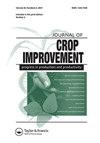Genetic diversity of Ethiopian potato (Plectranthus edulis (Vatke) Agnew) genotypes using simple sequence repeat markers
IF 1
Q3 AGRONOMY
引用次数: 0
Abstract
ABSTRACT Plectranthus edulis is among the most ancient and native tuber crops in Ethiopia, which is mainly cultivated by smallholder farmers. Being an orphan crop, it has not received due research attention. To tackle major crop-production constraints through breeding, knowledge of its genetic diversity is a prerequisite. Thus, the current study was carried out to assess the nature and extent of genetic diversity in 130 genotypes using 20 cross-transferable expressed sequence tag-simple sequence repeat (EST-SSR) markers developed from a related species, Plectranthus barbatus. Among the 20 SSR markers, 15 were transferable to Plectranthus edulis, from which 14 polymorphic markers were used for diversity analysis. A total of 101 alleles were detected, with a mean of 7.2 alleles per locus. Allele frequency ranged from 0.23 to 0.54, with mean value of 0.40. Polymorphic information content (PIC) ranged from 0.54 to 0.84, with a mean of 0.70, indicating a high level of informativeness. The Nei’s genetic distance ranged from 0.026 to 0.247, with the highest similarity being between Wolaita and Gamo Gofa populations. About 97% of the genetic variation was attributable to differences within populations; only 3% was attributable to variation among populations. The Neighbor-Joining cluster analysis grouped the 130 genotypes into three clusters. In general, the EST-SSR markers were effective in identifying genetic diversity in Ethiopian potato. This information can help to identify parental lines for crossing and exploiting the existing variability through selection.利用简单序列重复标记分析埃塞俄比亚马铃薯(Plectranthus edulis (Vatke) Agnew)基因型的遗传多样性
块茎植物是埃塞俄比亚最古老的块茎作物之一,主要由小农种植。作为孤种作物,它没有得到应有的研究重视。要通过育种解决作物生产的主要制约因素,了解其遗传多样性是一个先决条件。因此,本研究利用从近缘种barbatus Plectranthus开发的20个可交叉转移表达序列标签-简单序列重复(EST-SSR)标记,对130个基因型的遗传多样性性质和程度进行了评估。20个SSR标记中有15个可转移到毛竹上,其中14个多态标记用于多样性分析。共检测到101个等位基因,平均每个位点7.2个等位基因。等位基因频率范围为0.23 ~ 0.54,平均值为0.40。多态信息含量(PIC)在0.54 ~ 0.84之间,均值为0.70,具有较高的信息量。Nei群体的遗传距离在0.026 ~ 0.247之间,Wolaita与Gamo Gofa群体的相似性最高。大约97%的遗传变异可归因于群体内的差异;只有3%可归因于群体间的差异。Neighbor-Joining聚类分析将130个基因型分为3个聚类。总体而言,EST-SSR标记对埃塞俄比亚马铃薯的遗传多样性鉴定是有效的。这些信息可以帮助鉴定亲本系进行杂交,并通过选择利用现有的变异。
本文章由计算机程序翻译,如有差异,请以英文原文为准。
求助全文
约1分钟内获得全文
求助全文
来源期刊

Journal of Crop Improvement
Multiple-
CiteScore
3.30
自引率
7.70%
发文量
42
期刊介绍:
Journal of Crop Science and Biotechnology (JCSB) is a peer-reviewed international journal published four times a year. JCSB publishes novel and advanced original research articles on topics related to the production science of field crops and resource plants, including cropping systems, sustainable agriculture, environmental change, post-harvest management, biodiversity, crop improvement, and recent advances in physiology and molecular biology. Also covered are related subjects in a wide range of sciences such as the ecological and physiological aspects of crop production and genetic, breeding, and biotechnological approaches for crop improvement.
 求助内容:
求助内容: 应助结果提醒方式:
应助结果提醒方式:


